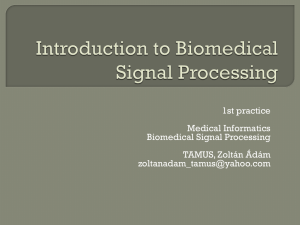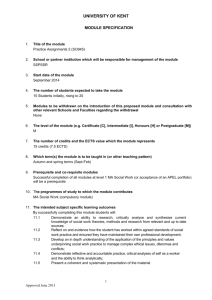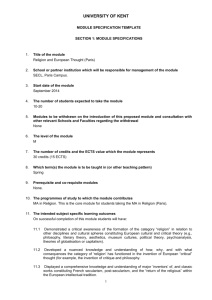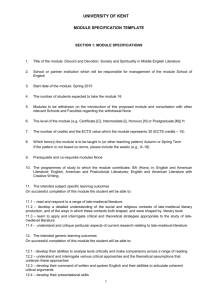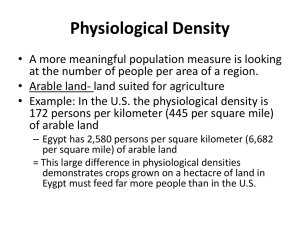ISBN-13: 978-0471676003
advertisement
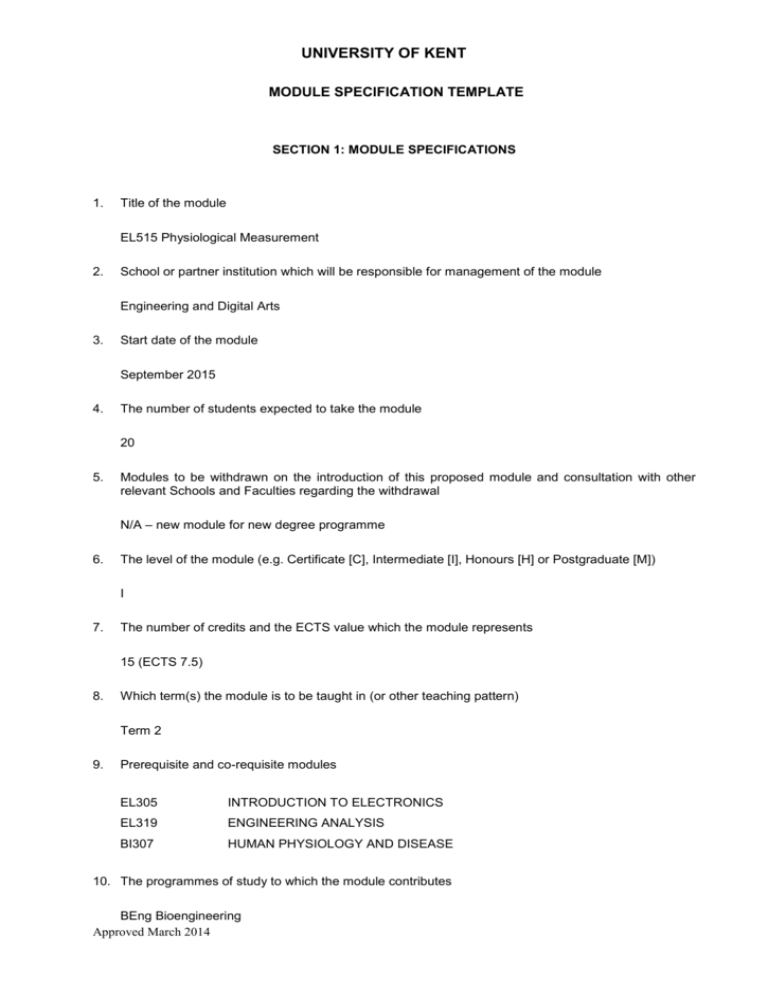
UNIVERSITY OF KENT MODULE SPECIFICATION TEMPLATE SECTION 1: MODULE SPECIFICATIONS 1. Title of the module EL515 Physiological Measurement 2. School or partner institution which will be responsible for management of the module Engineering and Digital Arts 3. Start date of the module September 2015 4. The number of students expected to take the module 20 5. Modules to be withdrawn on the introduction of this proposed module and consultation with other relevant Schools and Faculties regarding the withdrawal N/A – new module for new degree programme 6. The level of the module (e.g. Certificate [C], Intermediate [I], Honours [H] or Postgraduate [M]) I 7. The number of credits and the ECTS value which the module represents 15 (ECTS 7.5) 8. Which term(s) the module is to be taught in (or other teaching pattern) Term 2 9. Prerequisite and co-requisite modules EL305 INTRODUCTION TO ELECTRONICS EL319 ENGINEERING ANALYSIS BI307 HUMAN PHYSIOLOGY AND DISEASE 10. The programmes of study to which the module contributes BEng Bioengineering Approved March 2014 UNIVERSITY OF KENT BEng Bioengineering with a Year in Industry 11. The intended subject specific learning outcomes On successful completion of the module, students will: 1. Have an understanding of the principles of physiological measurement and instrument design. 2. Have knowledge of specific examples of physiological parameters and their measurement. 3. Have the necessary skills to design and analyse electronic instruments. 4. Develop an appreciation of the regulatory and safety issues relating to medical devices. These outcomes are related to the programme learning outcomes in the appropriate curriculum maps as follows: A2,A3,A8, B1,B3,B4, CE1,CE2,CE6,CE8 12. The intended generic learning outcomes On successful completion of the module, students will: 1. Be able to analyse, interpret and present experimental data in written form. This outcome is related to the programme learning outcomes in the Bioengineering curriculum maps as follows: D1, D4-D7. 13. A synopsis of the curriculum Lecture Syllabus AC CIRCUITS The phasor concept. Phasor relationships for R, L and C elements. Circuit laws using phasors. AC power. Instantaneous power. Average power. Effective value of a sinusoidal waveform. Maximum power transfer and conjugate matching. The transformer. Using transformers in circuit matching. ELECTRONIC DEVICES AND CIRCUITS Semiconductors, conductors and insulators. Conduction in semiconductors. N-type and P-type semiconductors. The PN junction. Biasing the PN junction, current voltage characteristics. The PN diode, ideal and practical models. The Zener diode. Optical diodes. Bipolar Junction Transistor (BJT) and Field Effect Transistor (FET). Basic operation, characteristics, parameters and biasing. The transistor as an amplifier. The transistor as a switch. Transistor packages. GENERAL PRINCIPLES OF MEASUREMENT AND INSTRUMENTATION Purpose, structure and classification of measurement systems. Systematic characteristics (range and span, errors and accuracy, linearity, sensitivity and hysteresis). Noise and noise reduction. Calibration, traceability and standards. Power supplies, regualtion and isolation. SENSING DEVICES Introduction of a range of sensors and transducers. Resistive sensors. Capacitive sensors. Ultrasonic sensors. Electromagnetic sensors. Optical sensors. Radiological sensors. Semiconductor sensing elements. Measurement of temperature, pressure, displacement, force and flow. Approved March 2014 UNIVERSITY OF KENT PHYSIOLOGICAL SIGNALS Body temperature. The circulation, blood flow and blood pressure. Muscles and the EMG.The heart, the ECG and micovolt cardiac potentials. Speech and speech therapy. Hearing and audiology. MEDICAL DEVICES Special requirements for medical instrumentation – size and weight, noise, isolation, and safety. Physiological measurement examples – temperature, flow, EMG, ECG, Audiometry, instrumentation for Speech Therapy. Regulatory and manufacturing requirements – CE marking and MHRA Medical Device Registration. Coursework EXAMPLES CLASS – GENERAL PRINCIPLES OF MEASUREMENT AND INSTRUMENTATION Two assessed classes. EXAMPLES CLASS – SENSING DEVICES Two assessed classes. EXAMPLES CLASS – PHYSIOLOGICAL SIGNALS An unassessed demonstration of examples of physiological measurement. 14. Indicative Reading List Recommended Reading Medical Instrumentation Application and Design John G, Webster (Ed) John Wiley & Sons; 4th Edition (6 Feb 2009) ISBN-10: 0471676004 ISBN-13: 978-0471676003 Background Reading Introduction to Electrocardiography Leo Schamroth Blackwell Science Ltd; 4th Revised edition (Sep 1971) ISBN-10: 0632084405 ISBN-13: 978-0632084401 An Introduction to the Physiology of Hearing James O. Pickles BRILL; 4th Revised edition (5 April 2013) ISBN-10: 9004243771 ISBN-13: 978-9004243774 15. Learning and Teaching Methods, including the nature and number of contact hours and the total study hours which will be expected of students, and how these relate to achievement of the intended module learning outcomes Lectures on AC Circuits and Electronic Devices and Circuits address learning outcomes 11.1 and 11.3; Lectures on General Principles of Measurement and Instrumentation, Sensing Devices and Physiological Signals address learning outcome 11.2 and lectures on Medical Devices address Approved March 2014 UNIVERSITY OF KENT learning outcome 11.4. These lectures are supported by examples classes on General Principles of Measurement and Instrumentation and Sensing Devices, which support learning outcomes 11.1 and 11.3, and Physiological Signals, which supports learning outcomes 11.2, 11.3 and 12.1. There will be 40 contact hours consisting of 35 hours of lectures and five hours of examples classes. Students will be expected to submit written solutions, as homework, for four of the five examples classes. The total student workload will be 150 hours. 16. Assessment methods and how these relate to testing achievement of the intended module learning outcomes Assessment for this module is by examination (80%) and coursework (20%). Students will be required to sit a formal examination, which will test subject specific learning outcomes 11.1, 11.2, 11.3, and 11.4. Additionally, the four assessed examples classes will test subject specific learning outcomes 11.1, 11.2 and 11.3 and generic learning outcome 12.1. The assessment and evaluation strategy has been devised to ensure that students develop the required knowledge and skills to which these topics relate. 17. Implications for learning resources, including staff, library, IT and space None. Some courses are shared with modules that are already running. It is anticipated that the remaining material (Physiological Signals and Medical Devices would be delivered by current staff.) 18. The School recognises and has embedded the expectations of current disability equality legislation, and supports students with a declared disability or special educational need in its teaching. Within this module we will make reasonable adjustments wherever necessary, including additional or substitute materials, teaching modes or assessment methods for students who have declared and discussed their learning support needs. Arrangements for students with declared disabilities will be made on an individual basis, in consultation with the University’s disability/dyslexia support service, and specialist support will be provided where needed. 19. Campus(es) where module will be delivered: Canterbury campus If the module is part of a programme in a Partner College or Validated Institution, please complete the following: 20. Partner College/Validated Institution: 21. University School responsible for the programme: Approved March 2014 UNIVERSITY OF KENT SECTION 2: MODULE IS PART OF A PROGRAMME OF STUDY IN A UNIVERSITY SCHOOL Statement by the School Director of Learning and Teaching/School Director of Graduate Studies (as appropriate): "I confirm I have been consulted on the above module proposal and have given advice on the correct procedures and required content of module proposals" ................................................................ .............................................. Director of Learning and Teaching/Director of Graduate Studies (delete as applicable) Date ………………………………………………… Print Name Statement by the Head of School: "I confirm that the School has approved the introduction of the module and, where the module is proposed by School staff, will be responsible for its resourcing" ................................................................. .............................................. Head of School Date ……………………………………………………. Print Name SECTION 3: MODULE IS PART OF A PROGRAMME IN A PARTNER COLLEGE OR VALIDATED INSTITUTION (Where the module is proposed by a Partner College/Validated Institution) Statement by the Nominated Officer of the College/Validated Institution (delete as applicable): "I confirm that the College/Validated Institution (delete as applicable) has approved the introduction of the module and will be responsible for its resourcing" ................................................................. .............................................. Nominated Responsible Officer of Partner College/Validated Institution Date …………………………………………………. Print Name ………………………………………………….. Post …………………………………………. Partner College/Validated Institution Module Specification Template Last updated February 2013 Approved March 2014


